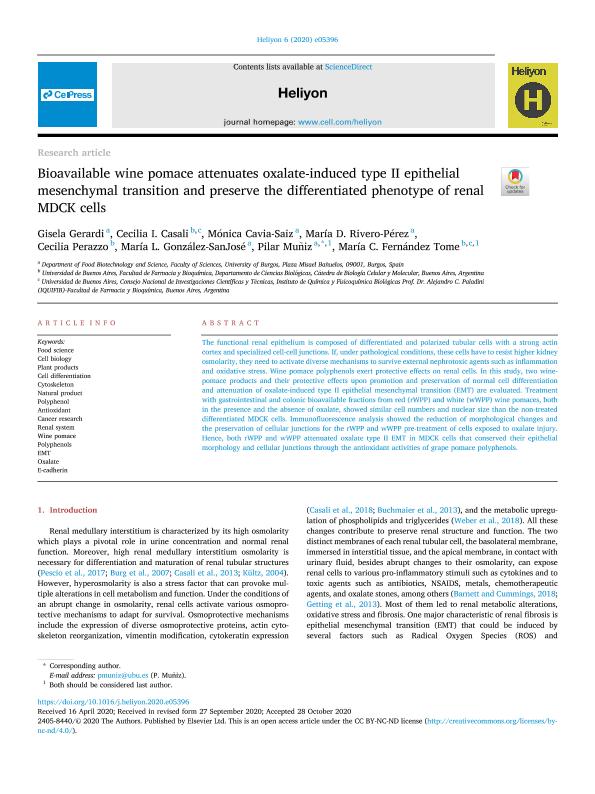Mostrar el registro sencillo del ítem
dc.contributor.author
Gerardi, Gisela
dc.contributor.author
Casali, Cecilia Irene

dc.contributor.author
Cavia Saiz, Mónica
dc.contributor.author
Rivero Pérez, María Dolores
dc.contributor.author
Perazzo, Cecilia
dc.contributor.author
González SanJosé, María Luisa
dc.contributor.author
Muñiz, Pilar
dc.contributor.author
Fernandez, Maria del Carmen

dc.date.available
2021-05-26T15:10:31Z
dc.date.issued
2020-11
dc.identifier.citation
Gerardi, Gisela; Casali, Cecilia Irene; Cavia Saiz, Mónica; Rivero Pérez, María Dolores; Perazzo, Cecilia; et al.; Bioavailable Wine Pomace attenuates oxalate-induced type II epithelial mesenchymal transition and preserve the differentiated phenotype of renal MDCK cells; Elsevier; Heliyon; 6; 11; 11-2020; 1-10
dc.identifier.issn
2405-8440
dc.identifier.uri
http://hdl.handle.net/11336/132560
dc.description.abstract
The functional renal epithelium is composed of differentiated and polarized tubular cells with a strong actin cortex and specialized cell-cell junctions. If, under pathological conditions, these cells have to resist higher kidney osmolarity, they need to activate diverse mechanisms to survive external nephrotoxic agents such as inflammation and oxidative stress. Wine pomace polyphenols exert protective effects on renal cells. In this study, two wine-pomace products and their protective effects upon promotion and preservation of normal cell differentiation and attenuation of oxalate-induced type II epithelial mesenchymal transition (EMT) are evaluated. Treatment with gastrointestinal and colonic bioavailable fractions from red (rWPP) and white (wWPP) wine pomaces, both in the presence and the absence of oxalate, showed similar cell numbers and nuclear size than the non-treated differentiated MDCK cells. Immunofluorescence analysis showed the reduction of morphological changes and the preservation of cellular junctions for the rWPP and wWPP pre-treatment of cells exposed to oxalate injury. Hence, both rWPP and wWPP attenuated oxalate type II EMT in MDCK cells that conserved their epithelial morphology and cellular junctions through the antioxidant activities of grape pomace polyphenols.
dc.format
application/pdf
dc.language.iso
eng
dc.publisher
Elsevier

dc.rights
info:eu-repo/semantics/openAccess
dc.rights.uri
https://creativecommons.org/licenses/by-nc-sa/2.5/ar/
dc.subject
ANTIOXIDANT
dc.subject
CANCER RESEARCH
dc.subject
CELL BIOLOGY
dc.subject
CELL DIFFERENTIATION
dc.subject
CYTOSKELETON
dc.subject
E-CADHERIN
dc.subject
EMT
dc.subject
FOOD SCIENCE
dc.subject
NATURAL PRODUCT
dc.subject
OXALATE
dc.subject
PLANT PRODUCTS
dc.subject
POLYPHENOL
dc.subject
POLYPHENOLS
dc.subject
RENAL SYSTEM
dc.subject
WINE POMACE
dc.subject.classification
Biología Celular, Microbiología

dc.subject.classification
Ciencias Biológicas

dc.subject.classification
CIENCIAS NATURALES Y EXACTAS

dc.title
Bioavailable Wine Pomace attenuates oxalate-induced type II epithelial mesenchymal transition and preserve the differentiated phenotype of renal MDCK cells
dc.type
info:eu-repo/semantics/article
dc.type
info:ar-repo/semantics/artículo
dc.type
info:eu-repo/semantics/publishedVersion
dc.date.updated
2021-04-28T21:29:03Z
dc.identifier.eissn
2405-8440
dc.journal.volume
6
dc.journal.number
11
dc.journal.pagination
1-10
dc.journal.pais
Países Bajos

dc.journal.ciudad
Amsterdam
dc.description.fil
Fil: Gerardi, Gisela. Universidad de Burgos; España
dc.description.fil
Fil: Casali, Cecilia Irene. Consejo Nacional de Investigaciones Científicas y Técnicas. Oficina de Coordinación Administrativa Houssay. Instituto de Química y Físico-Química Biológicas "Prof. Alejandro C. Paladini". Universidad de Buenos Aires. Facultad de Farmacia y Bioquímica. Instituto de Química y Físico-Química Biológicas; Argentina. Universidad de Buenos Aires. Facultad de Farmacia y Bioquímica. Departamento de Ciencias Biológicas. Cátedra de Biología Celular y Molecular; Argentina
dc.description.fil
Fil: Cavia Saiz, Mónica. Universidad de Burgos; España
dc.description.fil
Fil: Rivero Pérez, María Dolores. Universidad de Burgos; España
dc.description.fil
Fil: Perazzo, Cecilia. Universidad de Buenos Aires. Facultad de Farmacia y Bioquímica. Departamento de Ciencias Biológicas. Cátedra de Biología Celular y Molecular; Argentina
dc.description.fil
Fil: González SanJosé, María Luisa. Universidad de Burgos; España
dc.description.fil
Fil: Muñiz, Pilar. Universidad de Burgos; España
dc.description.fil
Fil: Fernandez, Maria del Carmen. Consejo Nacional de Investigaciones Científicas y Técnicas. Oficina de Coordinación Administrativa Houssay. Instituto de Química y Físico-Química Biológicas "Prof. Alejandro C. Paladini". Universidad de Buenos Aires. Facultad de Farmacia y Bioquímica. Instituto de Química y Físico-Química Biológicas; Argentina. Universidad de Buenos Aires. Facultad de Farmacia y Bioquímica. Departamento de Ciencias Biológicas. Cátedra de Biología Celular y Molecular; Argentina
dc.journal.title
Heliyon
dc.relation.alternativeid
info:eu-repo/semantics/altIdentifier/doi/http://dx.doi.org/10.1016/j.heliyon.2020.e05396
dc.relation.alternativeid
info:eu-repo/semantics/altIdentifier/url/https://www.cell.com/heliyon/fulltext/S2405-8440(20)32239-8?_returnURL=https%3A%2F%2Flinkinghub.elsevier.com%2Fretrieve%2Fpii%2FS2405844020322398%3Fshowall%3Dtrue
Archivos asociados
